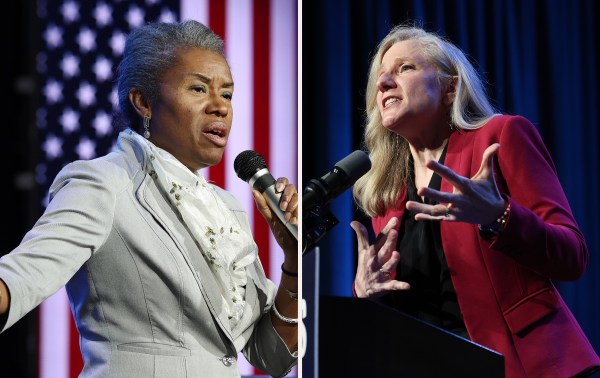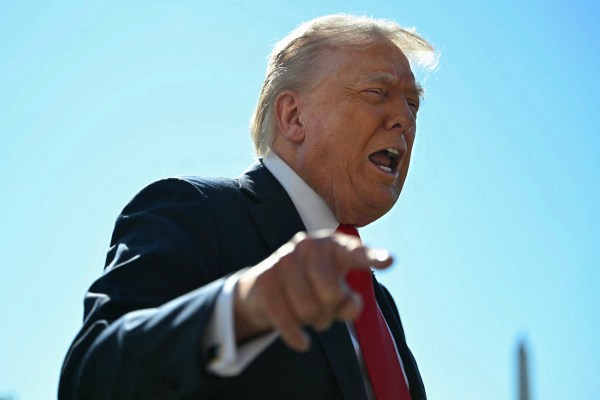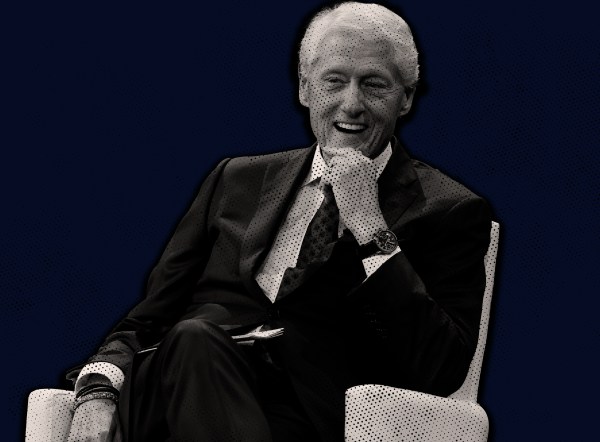You can judge a lot about someone from their choice in bumper stickers, and the same is true for the New Liberals.
The Center for New Liberalism (CNL), a grassroots advocacy organization with local chapters across the country, spells out nine core ideas on a handy sticker including “economic growth through free markets,” “a tech-optimist society,” and “deregulating barriers to housing and employment.” The last view listed on the sticker is “pragmatism over populism.”
That final tenet is at the heart of the debate over the future of the Democratic Party. Nearly a year has passed since the party found itself in the electoral wilderness, and the arguments over how Democrats can find their way back to the White House and to majorities on Capitol Hill are in full swing with the 2026 midterms approaching.
Is the answer a doubling down on progressive, economic populism? Is it a new messaging strategy spearheaded by a “Joe Rogan of the left”? Is it expanding the tent for moderate Democratic candidates willing to break from progressive political orthodoxies? Is it pursuing an abundance policy agenda?
A constellation of new advocacy organizations and groups have emerged focusing on the latter two. The Dispatch has covered the rise of these groups, which include Welcome PAC and its “CPAC of the center” policy conference, a new coalition of centrist lawmakers, a think tank, and naturally, a Substack.
CNL predates most of these groups. Its origins aren’t in the Washington, D.C., advocacy universe or Democratic Party politics, but in a Reddit politics forum, r/neoliberal. Jeremiah Johnson, then a consumer research data scientist, and Colin Mortimer, then a student at the University of Connecticut and now the group’s director, took over the forum in 2017. Fueled by wonky policy discussions, a robust stream of memes, and eye-catching social media rites, the online community grew to 175,000 people with many pushing for an abundance agenda well before there was a book about it.
The movement soon had enough steam to warrant some institutional structure, and Johnson and Mortimer established CNL, housing it within the Progressive Policy Institute (PPI), a decades-old centrist think tank influential in the New Democrat movement of President Bill Clinton. (In addition to his work with CNL, Johnson is a contributor to The Dispatch.)
The New Liberals now have more than 40 local chapters in the U.S. and a dozen more internationally. Mortimer sees CNL as working alongside the array of organizations pushing the Democratic Party in a more pragmatic direction, but he also told The Dispatch, “We take a lot of pride in the fact that we are the only grassroots group of real people who truly believe in these things.”
Several hundred of these New Liberals filled the Woolly Mammoth Theatre in downtown Washington last week for CNL’s fourth annual conference, the New Liberal Action Summit, to discuss how Democrats can win with a liberal agenda, often over and against the populist left.
What’s most interesting about CNL isn’t that it necessarily reflects a vast popular movement. The mainly college and young professional policy nerds that populated the conference are likely about as representative of the electorate as the progressives cheerleading Alexandria Ocasio-Cortez and Bernie Sanders.
What stood out was the focus on a positive political vision for Democrats and the country writ large. “We weren’t founded with the idea that some rich guy thinks we need to spend a bunch of money to influence the direction of the Democratic Party,” Johnson told The Dispatch. “This was just a philosophy, a way of thinking about government and the economy and society that people liked.”
The New Liberals embrace much of what has become known as an “abundance” agenda, a term popularized by Derek Thompson in The Atlantic and more recently in a book by Thompson and Ezra Klein. Put simply, the abundance vision sees progress as coming from expanding the pie, not simply redistributing it. The country would benefit from more plentiful and cheaper housing and energy, more public transit, better infrastructure, and greater scientific and medical innovation. Zero-sum economic thinking and layers of government regulation stand in the way of pursuing those goods, and too often, the barriers are highest in Democratic-run cities and states.
CNL wants policies that enable markets to grow and free the government to spend money effectively on projects that actually deliver results (e.g., high-speed rail), and that’s why Johnson doesn’t like calling himself a moderate or a centrist. “Maybe those words are useful sometimes, but they always apply like, ‘Oh well, the other guy has the ideas, and I’ll just do 30 percent of what he says, because I’m more moderate,’” he said. “I am not a moderate about housing. I want to build so much damn housing. I am not a moderate about free trade. I am wildly pro-free trade.”
The insistence that Democrats need to offer a constructive governing agenda, rejecting both a singular focus on Donald Trump and the left’s economic scapegoating of the richest Americans, is what attracted many of the summit attendees to CNL. “We can blame Trump all we want on the left, but we don’t take responsibility for delivering results,” Andy Lowe, a 27-year-old who works in pharmaceutical manufacturing and leads a CNL chapter in Raleigh-Durham, North Carolina, told The Dispatch. “That’s what I want to be a part of, what is the positive vision.”
Kevin Roberts, a 24-year-old legislative director for a Texas state Democratic representative and the president of the Austin Young Democrats, told The Dispatch that he was drawn to CNL’s focus on a substantive policy agenda. Roberts said he’s grown frustrated with the fringes on the left and right that mainly focus on opposing the other side: “I didn’t feel like those groups offered a tangible solution.”
The summit’s speakers featured a mix of policy wonks, political strategists, and moderate Democratic lawmakers, arguing that a positive, abundance-focused agenda is not only right on policy but an electoral winner.
“There’s no question that abundance has to be the center of any Democratic governance agenda going forward,” Rep. Josh Harder, a California Democrat who won a district that Trump carried in 2024, said during the summit. “[Abundance] allows us to be just as furious about the status quo as voters are.”
“One of my goals is to try to create the ideological superstructure, the enabling environment, to build out an agenda,” he added. “So when folks are actually raising their hand running for president in 2028 that they can actually talk about an agenda to build more housing, to lower electricity prices, to make life better for folks.”
But it’s not just Democrats in swing districts looking to liberalism to reshape their party’s agenda. “I want to be a member of the Democratic Party that is a party that can compete everywhere in the country,” Rep. James Walkinshaw said at the summit. He won a September special election in Virginia’s 11th Congressional District, which went for Kamala Harris by 30-plus points last November.
The Virginian believes that his party needs to avoid the error of seeking a messaging solution to a substance problem. “I’ve been in Democratic politics, campaigns, and government for more than 20 years now, and I’ve heard a million times that, ‘Democrats, we just have to have a better message,’” he said, noting that in any given cycle, the message could always be better. “But we have to be careful to avoid that kind of psychological cope. … Essentially what we’re saying is, if the voters just better understood how inherently perfect our policies are, we would win every election.”
But a growing body of data signals that Democratic woes run much deeper than a communications strategy. Polls of a generic congressional ballot, a useful metric for midterm chances, show Democrats only up 2.4 points against Republicans. That margin was nearly 10 points at this point in Trump’s first term. The party’s voter registration advantage over Republicans is disappearing in crucial battleground states but also in deep-blue parts of the country. The gulf between the Democratic Party and working-class voters is the widest it’s been in the last century, with Republicans now representing more of the country’s low-income districts than Democrats.
For progressives, the emerging answer is to double down on economic populism and affordability. But the New Liberals see such an agenda as not only reflecting bad policy but also likely to fail in overcoming the alienation voters feel from the party. “Donald Trump did not win on claiming that Democrats were too pro-free market,” Mortimer said. “Donald Trump did not win on claiming that Biden didn’t forgive enough student loan debt. He won by claiming our party is full of out-of-touch, far-left progressives, and the fact is America, by and large, does not disagree with that.”
Walkinshaw argued that Democrats should have learned by now that left-wing economic ideas won’t make the party more competitive in swing districts. “I wish it were the case that everywhere in the country we could just push the economics button hard enough, push the populism button hard enough that we can overcome the cultural divide, or the perceived cultural divide, between the Democratic Party and voters in those states and in those districts,” he said. “If that were the case, Sen. Sherrod Brown wouldn’t be trying to reclaim a seat. He’d still have a seat.”
Pete Brodnitz, a pollster and consultant, said that the left misunderstands economic discontent and what will connect with voters outside of deep-blue areas. “If you ask people what makes the economy successful in America, they’ll say, it’s hard work. It’s our enterprise. It’s our creativity. It’s our ability to take an idea and turn it into a business,” he told the summit audience. “What the party has been saying is change the social structure to increase fairness, take the billionaires and millionaires down a peg, reduce the big corporations and break them up and have anti-monopoly, and now we say as a defensive thing, we’re going to address prices.” Brodnitz argued that the current approach is reactionary and fails to align with the value voters place on getting ahead through hard work.
With just over a year before the midterms, it’s far from clear who will win the party’s internal debate. Greg Schultz, Joe Biden’s campaign manager during the 2020 primary, sees an uphill battle to push the party beyond the agenda of “a political-industrial consultant class.” Schultz believes that the Democrats’ branding problems are driven by activist interest groups and a small cohort of noisy left-wing lawmakers who get more attention than the more centrist majority-makers in the party.
Schultz contributed to a report, released Monday by Welcome PAC’s nonprofit arm, that was filled with data on the Democrats’ leftward drift and voters’ dissatisfaction with the party. “We do things that we think feel good and don’t win us over any persuadable voter, and don’t actually reinforce our standing with the average Democratic voter,” he told The Dispatch last week. “There’s a lot of ‘far left versus center’; I think it is, do we want to govern with majorities?”
For now, Democrats seem to be more comfortable running against Trump rather than for a positive agenda. Walkinshaw and CNL are looking to 2028 as the real test of whether the pragmatic forces in the party can beat out the progressives. “I don’t think between now and November of 2026 we’re going to settle all of these internal debates we have as Democrats about the future of the party,” Walkinshaw said. “I think that will play itself out in the presidential primary in 2028.”
Mortimer agreed: “I hope this infrastructure of pragmatic organizations can have the same place in the presidential race and debates within the party that are going to be happening in 2028 like the progressive groups had in 2020.”







Please note that we at The Dispatch hold ourselves, our work, and our commenters to a higher standard than other places on the internet. We welcome comments that foster genuine debate or discussion—including comments critical of us or our work—but responses that include ad hominem attacks on fellow Dispatch members or are intended to stoke fear and anger may be moderated.
With your membership, you only have the ability to comment on The Morning Dispatch articles. Consider upgrading to join the conversation everywhere.